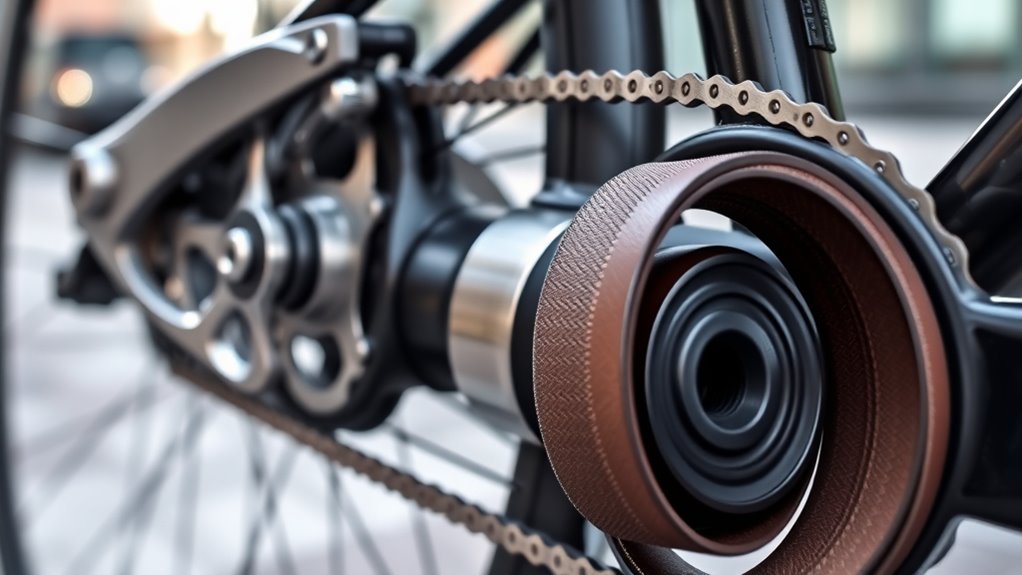When choosing gear systems, consider derailleurs for wide gear ranges and easy upgrades, ideal for versatile riding. Internal hubs offer low maintenance, durability, and reliable performance in urban or all-weather conditions, perfect for daily commuting. Belt drives provide clean, quiet operation with minimal upkeep but usually have limited gear options. Each system suits different riding styles, and understanding their strengths helps you pick the best for your needs—more details await to help you decide.
Key Takeaways
- Derailleurs offer wide gear ranges with quick, flexible shifting but require more maintenance and exposure to elements.
- Internal hubs provide sealed, low-maintenance gear options ideal for urban commuting and all-weather riding.
- Belt drives deliver quiet, clean, and low-maintenance operation, typically paired with a limited gear range.
- Choice depends on riding style: derailleurs suit performance riding, hubs favor durability, and belt drives prioritize cleanliness and low upkeep.
- Considering terrain, maintenance preferences, and gear range helps determine the best gearing system for your needs.

Have you ever wondered how your choice of gearing impacts your ride? It all comes down to the internal gear system and how gear ratios are designed to match your riding style. Internal gear hubs are enclosed mechanisms that house multiple gears within the wheel’s hub, offering a sleek, low-maintenance option. Unlike derailleurs, which shift gears on the outside of the bike, internal gear hubs keep everything protected from dirt and weather, making them ideal for commuting and city riding. When you select an internal gear setup, you’re choosing a system that provides a specific set of gear ratios, carefully calibrated to deliver smooth shifts and consistent performance. These gear ratios determine how easy or hard it is to pedal at different speeds or terrains, so understanding them helps you optimize your ride. For instance, a lower gear ratio makes climbing hills easier, while a higher one allows for faster cruising on flats. Your choice of internal gear system influences how many gear ratios are available—some offer just three or seven, while others boast up to 14 or more—giving you options to fine-tune your pedaling experience.
When considering internal gear hubs, think about your typical riding conditions. If you frequently ride in unpredictable weather or urban environments, a gear hub with a wide range of gear ratios can keep your pedaling comfortable, regardless of terrain. The gear ratios are incrementally spaced to provide a seamless transition between gears, so you don’t have to struggle with sudden jumps or awkward shifts. This consistency enhances your control and confidence, especially during stop-and-go city traffic or steep inclines. Additionally, internal gear hubs typically require less maintenance because they’re sealed away from dirt and moisture, making them reliable and long-lasting. Understanding gear ratios also plays a crucial role in selecting the most suitable internal gear hub for your riding style, ensuring optimal performance. Your choice of internal gear hub also impacts your overall riding efficiency. The gear ratios you select should match your cadence and power output, allowing you to pedal comfortably without excessive strain. Some hubs offer a gear ratio spread that favors easier climbing, while others optimize for speed on flat terrain. By understanding the relationship between gear ratios and your riding needs, you can select an internal gear system that maximizes comfort, efficiency, and durability. Whether you’re commuting daily or exploring new trails, the right internal gear and gear ratios make a significant difference in how smoothly and effortlessly you can ride. Ultimately, choosing the appropriate internal gear hub with suitable gear ratios helps you enjoy a more enjoyable, hassle-free cycling experience.
Frequently Asked Questions
How Do Derailleur Gears Compare in Weight to Hub Gears?
Derailleur gears are generally lighter than hub gears, making gear shifting easier and more responsive. You’ll notice that derailleur systems have fewer components, which reduces weight and simplifies maintenance. In a weight comparison, derailleur setups typically weigh less because they don’t require the bulky hub mechanism. If you’re looking for a lightweight, efficient gear shifting solution, derailleur gears are usually the better choice, especially for performance or racing bikes.
Are Belt Drives Suitable for Mountain Biking?
Belt drives are surprisingly tough for mountain biking, but they’re not the best choice for extreme trails. While they excel in durability and low maintenance, the constant jolts and mud of mountain trails can wear them out faster. If you’re tackling rugged terrains regularly, traditional derailleurs or hub gears might be more reliable. Belt durability is impressive, but under the harsh conditions of mountain biking, it’s wise to take into account other gearing options.
What Maintenance Is Required for Internal Hub Gears?
You need to regularly inspect your internal hub gears for proper function and guarantee smooth shifting. Keep the internal lubrication fresh by re-lubricating as recommended by the manufacturer, usually every few thousand miles or if you notice stiffness. Check for any signs of wear or damage during gear inspection, and clean the exterior to prevent dirt buildup. Proper maintenance keeps your internal hub gears shifting smoothly and prolongs their lifespan.
Can Belt Drives Be Used With Standard Bike Frames?
Yes, belt drives can be used with some standard bike frames, but you need to verify compatibility issues first. Carbon frames, in particular, may require specific modifications or adapters to accommodate belt drives. Not all frames are designed for belt drive tensioning systems, so ensure your frame has the necessary eyelets or mounts. Always confirm compatibility with your bike’s design before opting for a belt drive system.
Which Gearing System Offers the Best Efficiency for Commuting?
A chain is only as strong as its weakest link, and in commuting, efficiency matters most. You’ll find hub gears excel here, offering smooth gear shifting with minimal maintenance, maximizing gear ratio options for different terrains. They tend to be more efficient than derailleurs, especially in stop-and-go city riding. Belt drives also boost efficiency with less stretch and cleaner operation. Choose a hub gear system for reliable, low-maintenance commuting efficiency.
Conclusion
Choosing the right gearing system transforms your ride from ordinary to legendary. Whether you opt for derailleurs, hubs, or belt drives, each has its own magic—like a secret weapon in your cycling arsenal. Remember, your gear choice isn’t just about convenience; it’s about revealing your full potential on every ride. So pick wisely, gear up confidently, and prepare to conquer the roads like a superhero wielding the ultimate cycling weapon!









